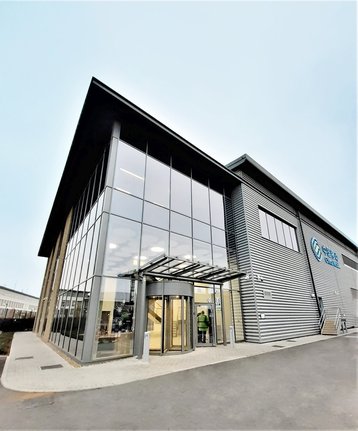The importance of digital infrastructure is widely accepted, and prioritized, by the UK Government and industry alike. Recognizing that digital infrastructure is the foundation of the digital economy underpinning our growth, the government’s Levelling Up White Paper, published in 2022, made enhancing digital connectivity a key ‘Mission’.
Since then, we’ve seen ambitious programs to both accelerate the commercial delivery of nationwide gigabit broadband, and ensure rural areas are not left behind. Significant public and private funding, such as that from Project Gigabit, has been unlocked to support this mission.
We’ve also made good progress in expanding wireless connectivity, with 92 percent of the UK landmass now covered by a good 4G signal from at least one operator according to Ofcom.
As these rollouts continue at pace across the country, another critical piece of the digital infrastructure puzzle are the data centers (DCs) that store and process our ever-growing data demands.
The UK has naturally become a global leader in DC investment, ranking second only to the US. However, to maintain our leadership position, we must begin to more strategically assess investment conditions and make more deliberate decisions on where to expand capacity.
The UK’s world-leading data center story
The economic importance of digital infrastructure as a catalyst for growth has long been understood, but an oft-cited report by TechUK in 2020 suggested that “data centers underpin an internet economy that contributes over 16 percent of domestic output, 10 percent of employment and 24 percent of total UK exports."
The report went on to state that each new data center contributes “between £397m and £436m Gross Value Added (GVA) per year to the UK economy while the GVA of each existing data center is estimated to lie between £291m and £320m per annum.”
It’s good news then that the commercial data center market in the UK has gone from strength to strength. The sector has consistently delivered very strong year-on-year growth and we now have the world’s second-largest (Europe’s largest) commercial cluster, with 517 data centers.
This, however, has been somewhat of a happy accident rather than the result of some intentional industrial strategy. TechUK went on to say that the “UK government has been very slow to recognize and support the sector that underpins our digital economy and enables so many of our key policy agendas."
The UK doesn’t boast exceptionally high scores in areas such as cheap energy, available land, straightforward planning, and taxation regimes, nor has it incentivized industry through subsidy.
In reality, the rise of the UK’s world-leading data center market is in large part down to the historic success of London as a commercial hub connecting North America and Europe.
As a result, commercial sites by and large are heavily clustered, with about 70 percent of the UK market in and around the M25 in areas such as Slough and Hayes, and the second largest cluster being in Manchester.
What’s changed?
For the UK to maintain its leadership position in DC’s, it’s not enough to just leave it to chance. A number of trends are now deciding investment flows both within the UK and on the global stage.
First, land and power availability. Access to land and power is becoming increasingly constrained in London and surrounding areas. For example, properties in Slough have gone up by 44 percent since 2019, and the Greater London Authority has told some developers there won’t be electrical capacity to build in certain areas of the city until 2035.
Data centers use large quantities of electricity, the equivalent of towns or small cities, in some cases, to power servers and ensure resilience in service.
In West London, Distribution Network Operators have started to raise concerns about the availability of powerful grid supply points to meet the rapid influx of requests from data center operators wanting to co-locate adjacent to fiber optic cables that pass along the M4 corridor, and then cross the Atlantic.
In response to these power and space concerns, the hyperscalers have already started to favor countries in Scandinavia. Microsoft, Google, Facebook, and AWS all have major data center operations hosted by Sweden for example, and it was recently named as the best place in Europe for data center investments by the global consultancy, Arcadis. Aside from space, the country ranks high for renewables availability, energy capacity, and security, as well as boasting a government that has long supported developments in the sector too.
Finally, the need for Edge computing, to realize the use cases that rely on high bandwidth, high reliability, and low latency, is becoming more important. That also means thinking about the oncoming AI boom too. AI's evolution hinges on robust connectivity. As more businesses start to leverage and build AI applications, the amount of data traveling through networks back to data centers will explode.
To support this, computational infrastructure that can support different types of AI use cases will need to be built out across the network Edge and core data centers. The underlying network's capacity to backhaul data for processing at data centers will be essential for this.
AI-enabling networks, needing high speeds and bandwidth, must be underpinned by robust backbone infrastructure capable of real-time functionality with ISP networks caching data near the end user for location-specific, low latency services. Adequate Points of Presence and strategically placed data centers will be essential to manage the rapid information flow cost-effectively and sustainably.
Use cases like autonomous vehicles, cloud gaming, and even just content delivery (as content becomes richer) are already driving a greater amount of data storage and processing being done nearer the end user, AI will expedite this trend. This will result in a greater distribution of Edge sites, supporting specific applications, depending on local needs.
Where next?
We’re now at a critical juncture. The quality and availability of our digital infrastructure underpins so many of our technology ambitions and is critical to our long-term productivity.
But, as discussed, a number of trends are now shifting how investment in data centers, a critical piece of the puzzle, is flowing.
The placement of these data centers will be crucial to maintaining the high speeds and low latencies that real-time applications demand. We will of course require further data center investment around London and further afield, but we also need to look at how our planning arrangements are encouraging or impeding investment.
Data centers are where industrial strategy meets digital strategy, but there is still far too little focus on DCs in the government's National Planning Policy Framework or the various industrial strategy whitepapers published in recent years.








